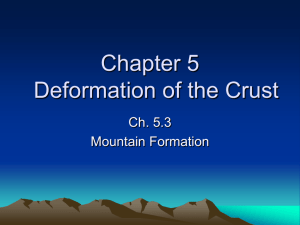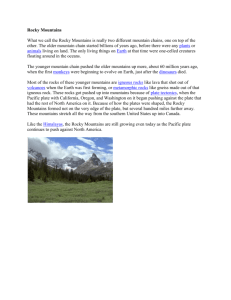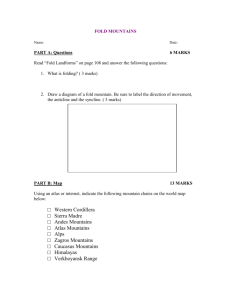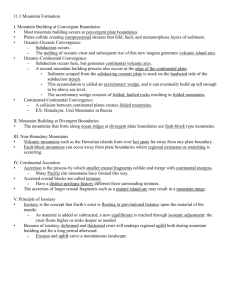GY 111 Lecture Note Series Mountain Building 1: The Basics
advertisement
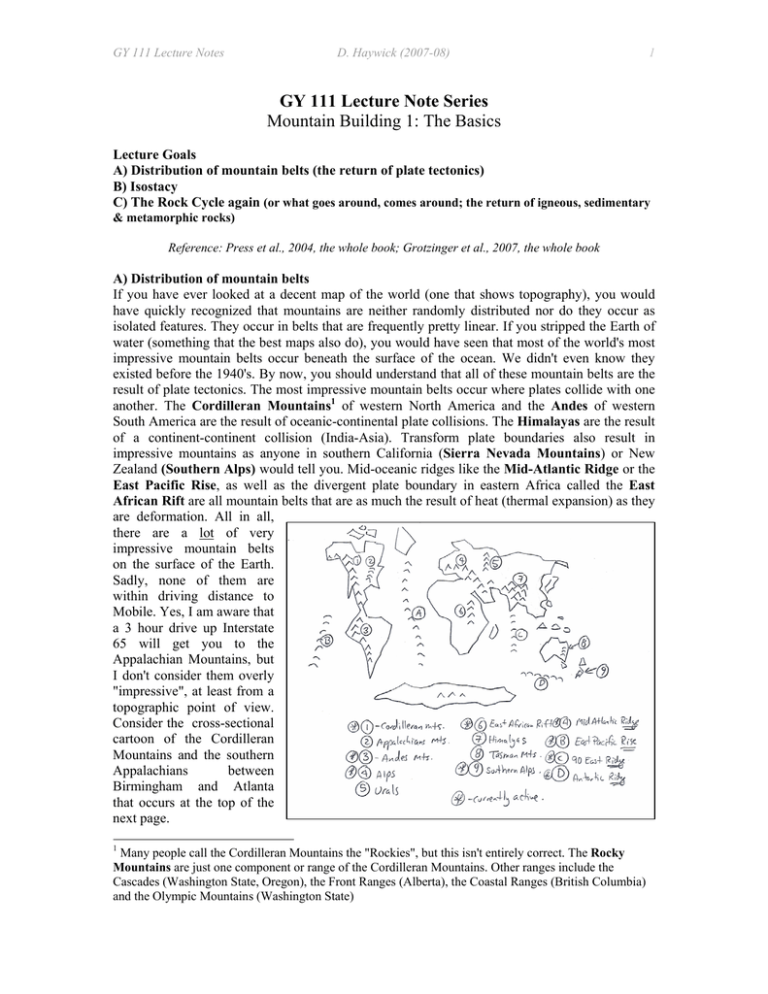
GY 111 Lecture Notes D. Haywick (2007-08) 1 GY 111 Lecture Note Series Mountain Building 1: The Basics Lecture Goals A) Distribution of mountain belts (the return of plate tectonics) B) Isostacy C) The Rock Cycle again (or what goes around, comes around; the return of igneous, sedimentary & metamorphic rocks) Reference: Press et al., 2004, the whole book; Grotzinger et al., 2007, the whole book A) Distribution of mountain belts If you have ever looked at a decent map of the world (one that shows topography), you would have quickly recognized that mountains are neither randomly distributed nor do they occur as isolated features. They occur in belts that are frequently pretty linear. If you stripped the Earth of water (something that the best maps also do), you would have seen that most of the world's most impressive mountain belts occur beneath the surface of the ocean. We didn't even know they existed before the 1940's. By now, you should understand that all of these mountain belts are the result of plate tectonics. The most impressive mountain belts occur where plates collide with one another. The Cordilleran Mountains1 of western North America and the Andes of western South America are the result of oceanic-continental plate collisions. The Himalayas are the result of a continent-continent collision (India-Asia). Transform plate boundaries also result in impressive mountains as anyone in southern California (Sierra Nevada Mountains) or New Zealand (Southern Alps) would tell you. Mid-oceanic ridges like the Mid-Atlantic Ridge or the East Pacific Rise, as well as the divergent plate boundary in eastern Africa called the East African Rift are all mountain belts that are as much the result of heat (thermal expansion) as they are deformation. All in all, there are a lot of very impressive mountain belts on the surface of the Earth. Sadly, none of them are within driving distance to Mobile. Yes, I am aware that a 3 hour drive up Interstate 65 will get you to the Appalachian Mountains, but I don't consider them overly "impressive", at least from a topographic point of view. Consider the cross-sectional cartoon of the Cordilleran Mountains and the southern Appalachians between Birmingham and Atlanta that occurs at the top of the next page. 1 Many people call the Cordilleran Mountains the "Rockies", but this isn't entirely correct. The Rocky Mountains are just one component or range of the Cordilleran Mountains. Other ranges include the Cascades (Washington State, Oregon), the Front Ranges (Alberta), the Coastal Ranges (British Columbia) and the Olympic Mountains (Washington State) GY 111 Lecture Notes D. Haywick (2007-08) 2 The Cordilleran Mountains are tall -- the highest mountains exceed 6500 m above sea level (e.g., Mt. McKinley in Alaska) -- and rugged. In contrast, the Appalachian Mountains are relatively short (most less than 2000m in height) and "rounded" (i.e., they have gentle slopes). If you examine the mountains portrayed in the cartoon map of the Earth on the previous page, you will see that some mountain belts are very rugged (the Alps, Andes, Himalayas) whereas others (the Urals, Tasmans) are smooth. The key to this character difference is the age of the mountain belts. Those that are rugged like the Alps and Cordilleran Mountains are relatively young. Those that are not like the Tasmans, the Urals and the Appalachians stopped growing 100s of millions of years ago. Since that time, they have been at the mercy of chemical and physical weathering. They have been eroding away and producing billions and billions of tons of sediment in the process. You know, the real mystery isn't why some mountain belts are rugged whereas others are not. It's why mountains that stopped growing 300 million years ago (Southern Appalachians) or earlier (e.g., the Urals formed about 500 million years ago), still have any positive topographic relief at all. You'd think that in that time, they would have been worn away to nothing. They would have been were it not for an important mechanism known as isostacy. B) Isostacy Let's consider the Appalachian Mountains for a few minutes. This mountain belt stretches from central Alabama all the way to Newfoundland (see GoogleEarth image to right) in eastern Canada2. If you compare the topography of the mountains in the south (e.g., Alabama-Georgia) with the north (Newfoundland) you will see that the southern mountains are considerably more "mountainous" then their northern equivalents. Once again, the difference is due to age. The forces that produced the northern portion of the Appalachians ended about 500 million years ago, but continued deformation in the south lasted until about 315 million years ago. The southern Appalachians have about another 185 million years before they are reduced to a peneplain. Still, even once this occurs, there is considerable evidence left behind that there was a mountain belt there in the past. Consider the following sketch of the structural elements in the Appalachian Mountains. Even though the topographic relief is gone, the faults, folds and rocks that are produced during a mountain building episode are still there: 2 and on to Ireland, England and the rest of the United Kingdom via Labrador and Greenland (but NOT Iceland) GY 111 Lecture Notes D. Haywick (2007-08) 3 We can recognize the remains of mountain belts a couple of billions of years old even though a mountain has not rested there for more than 1 ½ billion years. Moreover, some of the rocks now exposed at the Earth's surface contain minerals or feature suggesting that they originally formed well below the surface of the Earth (possibly 20 km or more down!). How could those rocks now be at the surface of the Earth? How could so much overburden have been removed? If you were to draw a cross-section through a major mountain belt like the Cordillera, you would find that the positive relief of the mountains is mirrored in the subsurface by what are called "continental roots". These roots are composed of the same material that the mountains are, namely continental crust. We usually envision continental crust to be composed of "granite"3, especially when we are discussing plate tectonics and subduction. You should remember this from earlier lectures; ocean crust (basalt) is more dense than continental crust (granite) which usually means that oceanic plate is subducted beneath continental plate in a convergent plate setting (see cartoon to right). But even though the continental crust is less dense than oceanic crust and the rest of the lithosphere it is resting on, it is still pretty "heavy". If you pile a lot more of this crust on top of it (e.g., by making mountains), the additional weight causes the crust to depress downward. If you are having trouble envisioning how low density material can sink into more dense material, consider this analogy using styrofoam. If you were to put one sheet of Styrofoam in a swimming pool, it would easily float on the water. Were you to put 50 sheets in a stack in the pool, you would observe that the Styrofoam still floats, but that many of the bottom layers have been pushed below the water surface (see cartoon). The Styrofoam below the surface is equivalent to the continental "roots" of the previous cartoon. As weathering and erosion removes the tops of the mountains (or the sheets of Styrofoam), and transportation moves the newly formed sediment onto nearby alluvial plains, the reduced weight forces the roots to rebound (this is isostacy). The more the rebound, the deeper the rocks that become exposed at the surface of the Earth. Once the roots have gone, isostacy can no longer 3 Continental crust is composed of more rocks than just granite, but the "average" composition closely approximates granite. The main thing is that continental crust is less dense than the rest of the lithosphere it rests on. GY 111 Lecture Notes D. Haywick (2007-08) 4 continue and the mountains are finally reduced to flat, peneplains. This process seeming takes about 500 million years to complete. C) The Rock Cycle again Now it is time to put all of this together. By this I mean the entire GY 111 class. We have talked about a lot of different concepts in this course, from basic mineralogy and mineral chemistry, to various rock types (igneous, sedimentary, metamorphic), weathering, soils, and lastly to rock deformation, structural geology and mountain building. Because of time constraints and the need to break the subject up into manageable bits, it was necessary to “compartmentalize” all of these subjects. And even though you are all eager-to-learn students (or should be!), you still tend to forget everything we discussed the minute you have been tested on it4. The truth of the matter is that EVERY aspect of this course5 is interwoven with every other aspect of the course. You can’t separate them from one another anymore than you can separate the veggies from the broth in an exceptionally well made cream of vegetable soup. And here's the important connection; if you are missing any one ingredient, the soup goes from being incredible to being unpalatable. This course is like that too. In order to make it an incredible experience, you need to appreciate the complex interrelationships of all of these rocks/minerals and processes that occur on and in the Earth. The best place to do this is in a mountain belt. We’ve discussed or will soon discuss the Cordilleran and Appalachian Mountains in this class, so let’s consider another range for this last topic of the day. The Himalayan Mountains straddle the borders of India, China, Pakistan, Tibet, Nepal and other somewhat troubled countries in south central Asia. They are the highest ranges on the planet. Mount Everest and K2 both exceed 9500 m (29,000 feet) above sea level. They are a comparably young mountain belt as India only really started to collide with Asia (near Tibet) a mere 40 million years ago. India didn't even break off from the rest of Gondwanna until about 80 MA. In comparison, the Cordilleran Mountains started their major period of growth around 150 MA and the Appalachians around 500 MA. The Himalayas are "babies" in comparison (at least in terms of age). A simplified south to north cross section from India to Tibet looks something like this: Note the scale. This cartoon has a greatly exaggerated vertical scale. The diagram summarizes the major plate tectonic elements across the mountain belt. The most prominent feature is the line of junction between the Indian Plate and the Asian (Tibet) Plate. Here continental crust is more 4 Want proof of this? See if you can answer this question: Compare and contrast idiochromic and allochromic. Pat yourself on the back if you even remember that those terms deal with color in minerals. 5 Actually it’s better to say every aspect of geology; there is still a lot of stuff that we haven’t done in GY 111 which is why all of you need to take GY 112 next semester! GY 111 Lecture Notes D. Haywick (2007-08) 5 than doubled in absolute thickness (almost 100 km).The junction line is called the suture line and it marks the place where India wedged under Asia. It is really hard to subduct granite under granite, and the two plates are now firmly stuck. The part of the Indian Plate south of India is still moving north at a rapid rate, but the front end of the plate (the part stuck under Tibet), isn't moving at all any more. It makes you wonder if and when (and where) the forward motion of the rest of the Indian Plate is going to cause new complications (e.g., perhaps a new subduction zone will develop south of India. Now let's dissect the Himalayan Mountains one rock type at a time (see the cartoon on the next page for a pictorial summary of the following paragraphs). Igneous rocks will be widely distributed throughout the mountain belt. They will vary from granite (instrusive felsic rocks in plutons within continental crust) and rhyolite (extrusive felsic rocks erupted from composite volcanoes on continental crust, to diorite and andesite (intermediate rocks associated with composite volcanos in island arc settings), to pegmaties, syenites, tuffs, volcanic ash etc. etc. etc. Even basalt and gabbro can occur in some parts of the mountain belt. Sedimentary rocks are equally well distributed in the Himalayas. First there are all of the Mesozoic and older sedimentary rocks that were there BEFORE the Himalayas began to form. Then there are all the sedimentary rocks (and sediment) that formed though the erosion of the mountains themselves. Expect immature sedimentary rocks like arkose and breccia in the mountains (alluvial fans), and more mature sedimentary rocks like conglomerate (river beds), red shale (river flood plains) and quartz arenite (point bars and beaches) in more distal areas of the sedimentary wedges that pass from the mountains to the adjacent plains. There were even shallow marine sediments deposited on both sides of the mountain belt (Indian and Tibetan sides) during the mountain building stage of the Himalayas. Don't forget metamorphism! As you know, convergent plate boundaries are where regional metamorphism occurs. Both heat and pressure induce metamorphic changes in this tectonic setting. Remember that the grade is highly variable. The close you are to the suture line, the greater the pressure. The deeper you go, the higher the temperature. Here you expect to find (and do) EVERY metamorphic rock conceivable. Contact metamorphism is also common in the vicinity of the plutons. You know, we'd be remise if we didn't also include a brief structural component to go along with the rock type summary. Rocks when permanently deformed, will either break (brittle deformation) or bend (ductile deformation). Breakage usually occurs along the leading edges of both sides of the mountain belt. In the Himalayas, this has resulted in a series of low angle reverse faults (called thrust faults; see next lecture) that radiate outward from the vicinity of the suture line (see last diagram on the next page). Ductile deformation (folding) is more common closer to the suture line because of higher confining pressure and temperature. Right along the suture line, pressure +/- temperature is so extreme that the rocks literally get metamorphosed past the point of "simple deformation". This means that you can't recognize enough bedding to be able to determine if the rocks were folded, or broken, or both. New metamorphic minerals simply overprinted everything. If you are the typical undergraduate student that I was when I first was told about how all this "stuff" fits together, you are probably thinking… wow; does it all really work like this?6 It actually took me a couple of years to fully appreciate the complexity of geology and in particular, of mountain belts, and even today, I marvel at how everything fits together so well. Even when 6 and will this be on the exam? The answer is to both is … yes! GY 111 Lecture Notes D. Haywick (2007-08) 6 GY 111 Lecture Notes D. Haywick (2007-08) 7 you add the isostacy component (recall that in 500 Million years the topography of the Himalayan Mountains, like that of the northern Appalachians, will be gone), geologists can still determine how, when, where, and why mountains formed in the first place. We do it today for mountains that formed 2 billion years ago. Good geologists learn to see the world around them in both a spatial and temporal way. So no matter how you look at it, geologists are special7 people. At least that's what my mother always called me. And mother is always right! Important terms/concepts from today’s lecture (Google any terms that you are not familiar with) Cordilleran Mountains Andes Himalayas Sierra Nevada Mountains Southern Alps Mid-Atlantic Ridge East Pacific Rise East African Rift Rocky Mountains Isostacy Peneplain continental roots suture line sedimentary wedge thrust faults 7 We really are you know. Geologists tell you where the Earth and all of its beasties (yourself included) came from (Earth history, evolution), and we tell you where we are all going (e.g., global warming/climate change, coastal changes). Geologists warn you when bad things are going to occur (volcanic eruptions, landslides, floods), and explain those events that we didn't quite predict accurately enough (earthquakes, asteroid impacts). Geologists keep you warm in the winter (natural gas/petroleum exploration), and cool in the summer (hydroelectricity generation – geologists plan where dams go; nuclear power generation – uranium is obtained from ores in igneous rocks; coal and gas-fired power plants – more energy reserves). The metal in your cars (metal ores), the glass in your windows (quartz), the salt for your potatoes (halite) and even the yucky tasting crap for your upset stomach (calcite) all came from the Earth and it was a geologist who found it. So yes, geologists are special and not in a short bus way.


